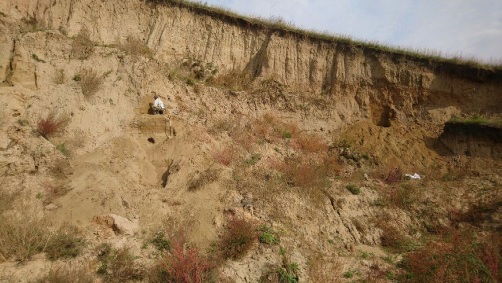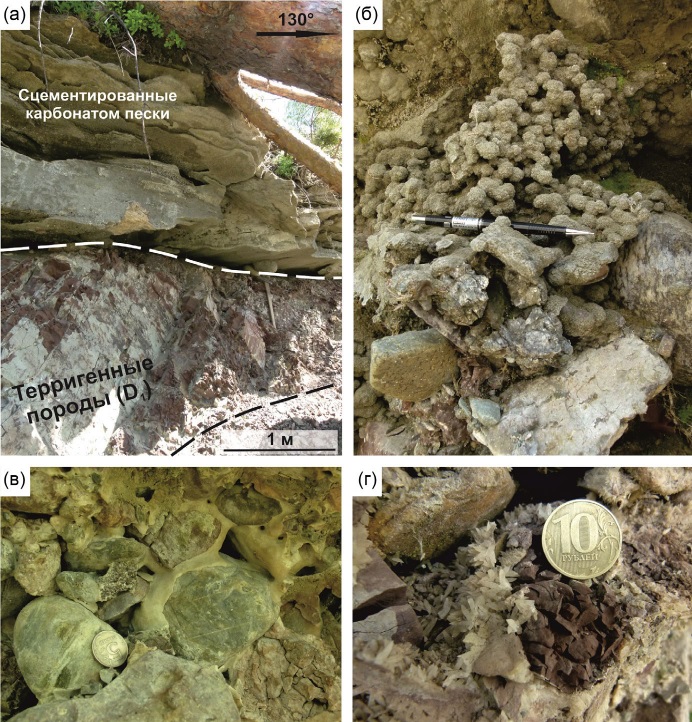Scientists have determined the time the megaflood event occurred in the Biya River valley (Altai). To this end, they have studied sections of its high terrace near Karabinka village and sampled both the sediments composing the terrace and bone remains contained in them for large-scale laboratory investigations.
The work was carried out by the staff of the Gorno-Altaisk Expedition of Sibirskoye PGO, with participation of researchers from the Trofimuk Institute of Petroleum Geology and Geophysics (IPGG SB RAS), Novosibirsk State University, and Tomsk State University. Evgeny Deev, Dr Sc (geol.-mineral.), chief research scientist, Geodynamics and Paleomagnetism Laboratory of IPGG SB RAS, was one of the most active participants in the project.

Fragment of the abandoned quarry wall exposing the Biya terrace near Karabinka village
Research object and conclusions
The focus of the research was a new section of the high (Biya) terrace on the Biya River near Karabinka village. The two identified sedimentary units are: lower (fluvial, formed in aqueous environment) and upper (subaerial, formed “under the air”, i.e. the condition where sediment is exposed to air). These correlate well with known sections of the Biya terrace in the vicinities of Biysk city and Staraya Azhinka village.
Results of deposits correlation, radiocarbon and optically simulated luminescence (OSL) dating reveal that the fluvial unit of the Biya terrace was accumulated by an enormous glacier-dammed lake outburst megaflood that traveled along the Biya River valley about 50–45 thousand years ago.
This was followed by the formation of the subaerial cover of the upper part of the terrace. For a long time, dammed lakes existed in the tributaries of the Biya River that were blocked by giant bars. The outburst floods of such glacier-dammed large lakes (in this case, Lake Teletskoye) which were not rare in ancient times, traveled from the Altai Mountains (Gorny Altai) to the cis-Altai plain through the Katun and Biya valleys. Exciting new finds
Interesting are the fossil finds from one of the beds in the lower part of the subaerial strata ― the fragments of a rib mammoth (Mammuthus sp.) bone and of a tibia bison (Bison sp.) bone. The radiocarbon dating allowed determining ages of the mammoth bone (over 51,500 ka) and the bison bone (46,000 ka), which may indicate the lower limit of the megaflood timing. The research also revealed that lakes formed beneath the ponds (subpond lakes) in the Biya tributaries blocked by large flood levees existed as early as 19.5 ─14.5 ka.
Calcite travertines were also found at the base of one of the sections of the Biyskaya terrace. Analysis of isotopic and trace element composition of travertines will help scientists build reconstructions of paleoclimatic environments and hydrogeological features of the region in the post-flood time.

Travertines from the Staraya Azhinka section: (a) - carbonate cemented sands overlying Paleozoic bedrock; (b) - sand-carbonate botryoidal aggregates; (c) - travertine crusts covering surfaces of alluvial boulders and pebbles; (d) - drusy-like calcite aggregates occupying void space between pebbles
Significance of the study
The researchers attach particular significance to the age determinations for the fluvial unit of the Biya thus considering it to be a regional stratigraphic marker that allows correlating Upper Pleistocene deposits of Gorny Altai with those from the cis-Altai Plain. In addition, it has been shown that sands deposited by the megaflood are suitable for OSL dating, thus allowing us to determine the age of major past hydrological events. These results will enable researchers deepen their further studies.
Finally, the obtained data have provided new insights and inferences about evolution of relief in the Altai region and about the formative role of the ancient processes occurring in this area.
The radiocarbon dating of travertines was performed within the frames of the state assignment of IPGG SB RAS (project FWZZ-2022-0001).
Published by IPGG Press Service
Photos courtesy of the researchers